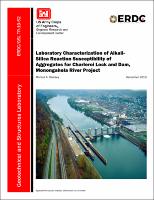Please use this identifier to cite or link to this item:
https://hdl.handle.net/11681/35118Full metadata record
| DC Field | Value | Language |
|---|---|---|
| dc.contributor.author | Ramsey, Monica A. | - |
| dc.date.accessioned | 2020-01-10T20:49:43Z | - |
| dc.date.available | 2020-01-10T20:49:43Z | - |
| dc.date.issued | 2019-12 | - |
| dc.identifier.govdoc | ERDC/GSL TR-19-52 | - |
| dc.identifier.uri | https://hdl.handle.net/11681/35118 | - |
| dc.identifier.uri | http://dx.doi.org/10.21079/11681/35118 | - |
| dc.description | Technical Report | - |
| dc.description.abstract | The purpose of this study was to identify potential alkali-aggregate reactivity of local aggregates provided by the Pittsburgh District according to ASTM C1260 and to investigate the effectiveness of a combination of cementitious materials and aggregates from provided mixture designs in suppressing alkali-silica reactivity (ASR) induced expansions according to the ASTM C1567. Three ASTM C1260 tests were performed for each aggregate (Hanson, Georgetown, and Shelly). A total of 48 ASTM C1567 tests were performed from the combination of the four mix designs, four fly ash sources, and three aggregate sources. The limiting criteria for the proposed materials and mix designs was expansions less than 0.08% at 30 days of testing in accordance to the Unified Facilities Guide Specification (UFGS) Division 03 Concrete Section 03 30 00.50. Based on this specification, the tested aggregates are considered potentially reactive with 30-day mortar bar expansions of 0.1970% for Hanson, 0.1683% for Georgetown, and 0.1623% for Shelly. However, all 48 combinations of the ASTM C1567 tests passed the limiting criteria with 30-day expansions less than 0.08%. These results indicate that the constituent project materials in the proposed mix designs can effectively mitigate ASR. | en_US |
| dc.description.sponsorship | United States. Army. Corps of Engineers. Pittsburgh District. | en_US |
| dc.description.tableofcontents | Abstract ................................ ................................ ................................ ................................ ... iii Figures and Tables ................................ ................................ ................................ ................... v Preface ................................ ................................ ................................ ................................ ..... vi 1 Introduction ................................ ................................ ................................ ...................... 1 1.1 Background ................................ ................................ ................................ ........ 1 1.2 Problem statem statement ................................ ................................ ............................ 1 1.3 Objective and scope ................................ ................................ .......................... 2 2 Materials ................................ ................................ ................................ ........................... 3 3 Experimental Program ................................ ................................ ................................ .... 4 4 Results and Discussion ................................ ................................ ................................ ... 8 4.1 ASTM C 1260 ................................ ................................ ................................ ...... 8 4.2 ASTM C 1567 ................................ ................................ ................................ ...... 9 4.2.1 Mix 1 .......................................................................................................................... 11 4.2.2 Mix 5 .......................................................................................................................... 13 4.2.3 Mix 7 .......................................................................................................................... 15 4.2.4 Mix 10 ........................................................................................................................ 17 5 Summary and Conclusions ................................ ................................ ........................... 19 Appendix A: Material Reports ................................ ................................ ............................. 20 Appendix B: Worksheets for ASTM C 1260 ................................ ................................ ........ 41 Appendix C: Worksheets for ASTM C 1567 ................................ ................................ ........ 45 Unit Conversion Fa ctors ................................ ................................ ................................ ....... 94 Report Documentation Page | - |
| dc.format.extent | 103 pages / 8.138Mb | - |
| dc.format.medium | PDF/A | - |
| dc.language.iso | en_US | en_US |
| dc.publisher | Geotechnical and Structures Laboratory (U.S.) | en_US |
| dc.publisher | Engineer Research and Development Center (U.S.) | - |
| dc.relation.ispartofseries | Technical Report (Engineer Research and Development Center (U.S.)) ; no. ERDC/GSL TR-19-52 | - |
| dc.rights | Approved for Public Release; Distribution is Unlimited | - |
| dc.source | This Digital Resource was created in Microsoft Word and Adobe Acrobat | - |
| dc.subject | Alkali-silica reaction | en_US |
| dc.subject | Mortar bar | en_US |
| dc.subject | Concrete | en_US |
| dc.subject | Hydraulic structures | en_US |
| dc.subject | Mitigation | en_US |
| dc.subject | Supplementary cementious material (SCM) | en_US |
| dc.subject | Alkali-aggregate reactions | en_US |
| dc.subject | Aggregates (Building materials)--Testing | en_US |
| dc.subject | Charleroi (Pa.) | en_US |
| dc.title | Laboratory characterization of alkali-silica reaction susceptibility of aggregates for Charleroi Lock and Dam, Monongahela River project | en_US |
| dc.type | Report | en_US |
| Appears in Collections: | Technical Report | |
Files in This Item:
| File | Description | Size | Format | |
|---|---|---|---|---|
| ERDC-GSL TR-19-52.pdf | 8.33 MB | Adobe PDF |  View/Open |